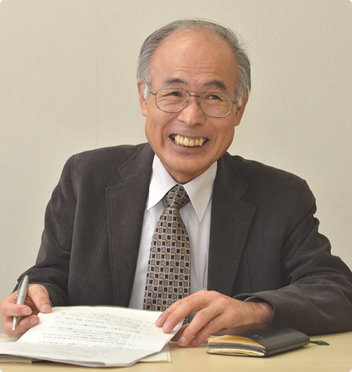The brain tells us how to apply mathematics and physics in the development of products and production equipment.
Dealing with difficult tasks in various fields at Nikon.
What kind of products were you involved with at Nikon?
I participated in the development of IC and LCD steppers and scanners, cameras, measuring instruments, surveying instruments and Nikon production equipment. I was also involved with development of the company's element technologies conducted in collaboration with Nikon Core Technology Center, which focuses on research and development of fundamental technologies.
So, you were involved in every aspect of operations. Could you tell us about some of the development projects you participated in?
I worked on the development of algorithms for a measuring instrument that evaluates the focal precision of a lens installed in IC steppers and scanners. For this, I adapted a function in the Shack-Hartman sensor generally employed in the adjustment of an astronomical telescope. I am still engaged in the development of IC steppers and scanners, as they are constantly evolving. For imaging products, I developed a system that measures wavefronts of interchangeable lenses. This is a technology that adapts knowhow accumulated during the development of IC steppers and scanners, and which was also extended for use at the company's mass-production plants.
What roles did you take in the field of measuring instrument development?

For one, I dealt with improving the efficiency of measuring shapes with a touch probe. In shape measurement, you measure concavity, convexity and undulation of the mold or aspherical lenses. Accurate measurement is extremely difficult. One needs to know exactly which part of the touch probe is contacting which part of the subject. We may experience the dilemma of not knowing where the probe is touching because you don't know the shape you are measuring.
In the past, calculations were repeated many times and revised, to adjust speculation of a shape little by little. But I succeeded in developing an algorithm that determines a shape with one calculation, utilizing differential geometry. Calculation speed and accuracy have been vastly improved with a resulting increase in work efficiency.
You use your knowledge of mathematics and physics in a variety of fields. Could you tell us one of the most memorable stories?
I recall a study related to the measurement of polarization*1. This is a slightly complicated story. Polarization is quantified by a complex number*2, meaning that the amount of polarization is not calculable by direct calculation. But I managed to make this possible by utilizing the algorithm from an abstract mathematical concept called a Lie group*3, enabling direct measurement of the polarization amount. This concept of the Lie group is frequently used in the research of elementary particles, but almost nowhere else.
- *1Polarization: Light consists of electromagnetic waves. Polarization specifies the orientation of a wave's magnetic field, perpendicular to the wave's direction of travel.
- *2Complex number: A mixture of real and imaginary numbers.
- *3Lie group: A differentiable manifold is an algebraic structure. Its group structure is compatible with differentiable structure. Lie groups represent the study of the infinitesimal transformation and the continuous group, which was developed by Norwegian mathematician Marius Sophus Lie.
While deeply involved in thinking, all of a sudden, my brain told me how to proceed.
Tell us how you succeeded in making your breakthroughs.

The secret lies in my graduate school. It was immediately after I enrolled into a graduate school, when I used my own arbitrary error allowance bars* in an experiment. My mentor accused me of misbehavior, saying, "error allowance is a matter of conscience that a laboratory researcher should always keep in mind."
My mentor was very strict concerning the management and calibration of the instruments used in measurement, insisting on "absolute measuring." He taught us that what is important is not the measuring itself but the guarantee of measurement precision.
- *Error allowance bars: Guaranteed margins of error in measurement displayed on a graph.

The above graph is a reproduction of error allowance bars. Sawada uses this concept to represent his code of conduct as a researcher.
So, you are abiding by your mentor's teaching.
In measurement, finding the "true value" is like having the knowledge of a god. We do our best to come as close as possible to the value within a limited time, making use of every means available.
What is important is whether you have the confidence to say, when the results come out, "I did all I could to obtain this measurement. There may still be errors, but I guarantee that they are limited within the boundaries I have specified."
The secret of success lies in having a sincere attitude towards your subject.
Yes, a sincere attitude is a must. My efforts opened a path I had never thought possible. When I stuck to a subject for a certain time struggling to find the right direction, I encountered a moment when a solution came to me. I explain this phenomenon as my brain telling me the way. It was when I was in a bathtub that the polarization measurement idea utilizing the Lie group theory popped into my brain. It was a sudden revelation of my brain.
Tell us about the future of Nikon and the possibility of mathematical analysis in monozukuri (manufacturing) Japan.
Mathematical analysis has still so much to contribute to support Nikon precision and quality for today and tomorrow.
We know Japan is becoming an aging society with a falling birthrate. We need to plan for a new monozukuri (manufacturing) society, where a different style of manufacturing must be designed. In this respect, mathematical analysis has high potential. It requires no natural resources. What's needed is ideas and intelligence that result in greater possibilities and a wider scope of adaptation. More emphasis should be placed on this area of business.
